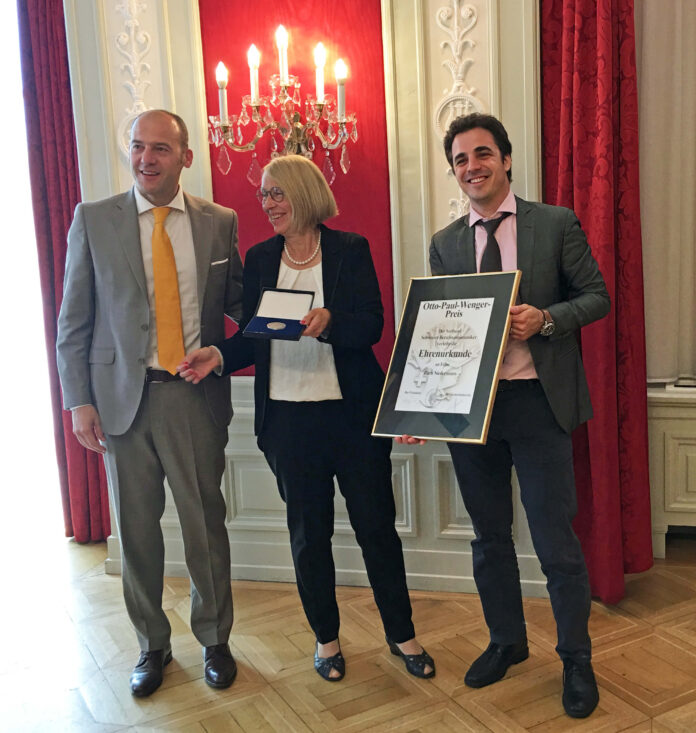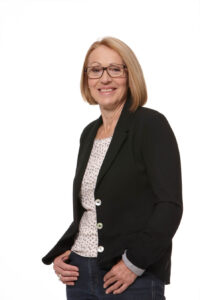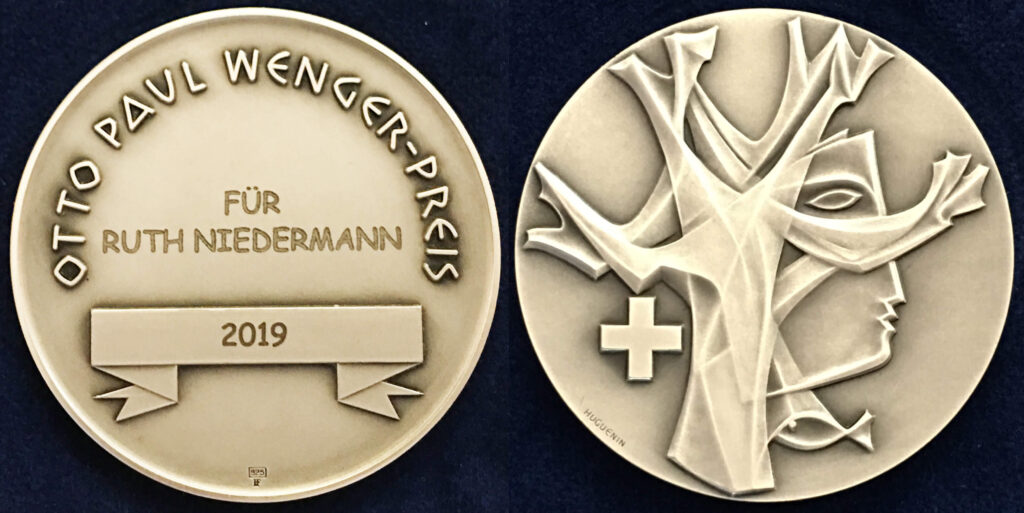
Ruth Niedermann is a highly esteemed colleague in the numismatic world. On 17 June 2019, the owner and editor of the Numis-Post was honoured by the Association of Swiss Professional Numismatists with the Otto Paul Wenger Prize. Read here the laudation given by Ruedi Kunzmann:
Family life
We look to the east of Switzerland, to Rüthi in the St. Gallen Rhine Valley, where family Schneider lives. Ruth is the oldest daughter; she has a sister, Edith, and a younger brother, Urs.
It is a special family. The parents run a business that later turns into a trading company. The upbringing is strict but fair, everybody helps in the business and in the household – in the house of the Schneider family, there is no men’s or women’s work. There is work.
Since Ruth can remember (and to the annoyance of her mother), coins are positioned in the whole apartment: on the backrest of the corner bench in the kitchen, on the bedside table, on the margin of the washbasin in the bathroom. Only the living room is “coin free”, unless a coin dealer friend is visiting – at least a small victory for Mrs. Schneider. And when the visit is over, every coin has to be removed from the room.
After primary school in Rüthi and two years of secondary education in the monastery boarding school in the Principality of Liechtenstein, Ruth finishes her secondary education with a third year in Neuchâtel – a linguistic challenge. Afterwards, she undertakes a commercial apprenticeship at the company Toko in Altstätten – yes, the one with the ski wax. She stays with the company for several years and is repeatedly allowed to take long breaks for extended stays in England; Toko seems to be a quite generous company.
Stays in England
In England, Ruth attends a school of commerce first and qualifies later to study at the London Polytechnic. At some point, Ruth gets to know Paul Davis and his wife (due to her sister). Paul takes Ruth to all the auction houses and introduces her to numerous English coin dealers; a wonderful friendship develops that continues to this day.
During her stays in England, Ruth lives mainly on her savings, but from time to time, she earns a decent pocket money dealing coins from Switzerland and Liechtenstein.
In London, Ruth meets a former schoolmate who introduces her to the world of classical music and who is glad to find someone that accompanies him to the big concerts. The pleasure of classical music stayed with her until today.
However, she did not meet her husband, Markus, in London, but at an asparagus reception in the house of her boss from Toko. What was arranged by her boss worked out the very same evening. By now, the two are married for more than 40 years and have raised four children. For a few years, Ruth also took care of her youngest godchild within the family.
The background of the Numis-Post
Now, let us turn to numismatics and thus to the magazine Numis-Post.
Hans Schmid from Arbon (Canton of Thurgau), a collector and amateur dealer of different antiques, shifts his interests to the field of numismatics at the beginning of the sixties. In 1968, he founds the so-called Numis-Post whose first issues only consist of a few photocopied pages and he distributes these amongst acquaintances at coin fairs and collectors’ meetings. Keep in mind: those are the years of the introduction of the new copper-nickel coins of Switzerland; the field of numismatics is booming tremendously. While the first sample issue of July 1968 only has a circulation of 2,000 copies, in the beginning of 1969, this number increases to 10,000 – those were the days!
Unfortunately, Hans Schmid dies completely unexpectedly at the age of 55 in July 1977, shortly after he sold his business to be able to focus entirely on the Numis-Post. Subscribers and advertisers request the continuation of the magazine from Hans Schmid’s heirs.
It is a fortunate coincidence that Hans Schmid’s friend and fellow coin collector, Gottlieb Schneider, Ruth’s father, takes over the Numis-Post at issue number 9/1977. This allows the magazine to thrive further – as the numbers of subscriptions, advertisers and newsstand sales prove –, since Schneider is well networked in the numismatic scene in the east of Switzerland and in the Principality of Liechtenstein. In his spare time, he often meets René Holenstein from Heerbrugg, the founder of MoneyTrend, yes, this magazine also comes from that region. Ruth is often present when her father and Holenstein talk shop night after night in his home in Eschen (LIE), because Holenstein is a great radio amateur and has contacts all over the world. Sometimes, this is also for Ruth more adventurous than the discussions on coins.
Gottlieb Schneider is planning on handing over his business to his son to be able to focus entirely on the Numis-Post. But just like his predecessor, he did not have this opportunity. At the end of November 1984, he dies unexpectedly at the age of 57.
The Numis-Post in the hands of siblings
After the death of Gottlieb Schneider, the first issue of the Numis-Post is put together as a teamwork of the three siblings. Fortunately, all of them had already taken care of individual tasks of the Numis-Post before (auctions = Edith, editorial = Ruth, finances = Urs). The beginning is difficult – nobody was waiting for the two Schneider siblings, especially not for 22-year-old Urs Schneider. Nevertheless, Ruth and Urs take charge of the (again) orphaned magazine. The most important innovation taking place is the separation of the publishing house and the magazine on the one hand from the auctions (named Pea-Nut AG) on the other hand; Ruth continues to manage the publishing company, her brother takes charge of the coin trade and the auctions.
Hardly anyone knows that during her media education taking place around the turn of the century, Ruth is flirting with different media. She commits to the Swiss Women’s Sports Association (Schweizerischer Frauensportverband) and takes over the journalistic and financial responsibility of the association’s monthly magazine and the two annual education programmes. Those magazines have circulations of more than 40,000 copies each, with 80 pages, all A4, in colour, with pictures of sport events, training camps, trips organised by the association and huge emotions. But after a few years, Ruth returns for good to the (men’s) world of numismatics and focuses completely on the Numis-Post.
Back in those years, there was another purely Swiss numismatic magazine, the Helvetische Münzen Zeitung or HMZ founded by Albert Meier from Hilterfingen in 1966. Since 1985, the magazine has been run by Hans-Peter Capon, Zurich, and later by Madulain. In 2002, Hans-Peter Capon decides to take on a new challenge in his life and offers Ruth the HMZ for sale. They come to an agreement quite quickly, Ruth is excited to get to know “the other side” and approaches the new environment with great care.
For Ruth Niedermann, the success of the Numis-Post (as you know: for some time, the magazine has been called Numis-Post & HMZ) was not at any time of existential importance. That was quite helpful while dealing with hard times and it gave her also a certain neutrality. Above all, she considers herself a service provider in the field of numismatics. In the many years that Ruth Niedermann has been in charge of the Numis-Post (as the magazine is called since 2010 with its original name again), she has been able to get the different numismatic associations of our country on her side. That means that by now, the magazine has become the publication medium for the activities of different collectors’ associations. Ruth is often part of the board of the associations and I can assure you from my own experience that she makes a significant contribution to the work of the board.
The family shows a consistent interest in the long-term future of the Numis-Post. That reassures us and certainly also all colleagues of the Association of Swiss Professional Numismatists regarding the time to come.

Private life? Of course!
Now we got to know Ruth as a businesswoman, but does she have a private life? Oh yes, and it would not suit her not to have one. For a person that well organised having a private life is no challenge.
Ruth plays tennis regularly. She retired from competing a few years ago. Playing regularly on Thursday mornings is sacred to her. Even if she is under-challenged from the athletic point of view, the weekly contact with the three friends coming from completely different professional lives is very important to her. She calls the tennis lessons “psychotherapy”.
Ruth travels, hikes and reads a lot. She rather holds a magazine, a newspaper or a book in her hands than to read an electronic version. She also likes to cook and to eat and in the family’s cellar, a few nice wines are stored. There are even a handful of bottles that are her very own and that she guards meticulously!
Numerous books on the monetary system are also stored in the cellar – we got back to the field of numismatics. I do not believe that Ruth makes any money with this storage, it is probably above all another cause of work. Eventually, she gives the shelf warmers as presents to associations in the east of Switzerland, youth members, etc. But of course, she prefers to sell the books!

Numismatic anecdotes
At the end, perhaps two brief numismatic anecdotes: Ruth built up a small collection of Bündner coins in her youth and at the beginning of her marriage with Markus. But due to the work caused by the magazine and the family, there was no time left for collecting anymore. There are even said to be numismatists who know better what part of her collection is than she does.
During the silver boom in the 1980s, Ruth worked on a weekly basis in the company of her father in Rüthi. At that time, there were piles of silver in the office – that big, that her daughter Sara loaded silver money instead of sand on the tipping tray of her tricycle. They worked so much in those days that unfortunately, there is no picture of these scenes.
Well, now you know Ruth Niedermann at least as well as she does herself and presumably, we do all agree that the Association of Swiss Professional Numismatists made the perfect choice regarding the winner of this year’s Otto Paul Wenger Prize.
You can find out more about the Association of Swiss Professional Numismatists on their website.
Get more information on the Swiss numismatist Otto Paul Wenger in this German Wikipedia article.


